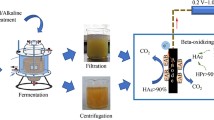Abstract
Batch tests were carried out to study the possibility of hydrogen production from alkali-pretreated sludge without seed and the pH dependency of hydrogen fermentation from alkali-pretreated sludge. Experimental results showed that the sewage sludge with alkali-pretreatment could be successfully applied to biologically producing hydrogen without seed and extra-feed. The results also showed that the initial pH value of sewage sludge was an important factor throughout the hydrogen fermentation of alkali-pretreated sludge. The maximum hydrogen yield was obtained at initial pH value of 11.0 (14.4 mL·g VS−1). The hydrogen yield of alkali-pretreated sludge at alkaline initial pH value was much higher than that of acidic or neutral initial pH value. The optimal pH value of hydrogen production from alkali-pretreated sludge was approximately 9.5. The consumption of hydrogen could be inhibited when the pH value of sludge was above 8.5. The change of hydrogen yield at various initial pH values was similar to that of sludge SCOD. The change of sludge pH value was slow and acetate was the major component of volatile fatty acids produced in the process of hydrogen production. The yield and the constitution of volatile fatty acids were sensitive to the initial pH value.
Similar content being viewed by others
References
Parkin, B. G. F., Owen, W., Fundamentals of anaerobic digestion of wastewater sludges, J. Environ. Eng. ASCE, 1986, 112 (5): 867–920.
Weemaes, M. P. J., Verstraete, W. H., Evaluation of current wet sludge disintegration techniques, J. Chem. Technol. Biotechnol., 1998, 73: 83–92.
Reith, J. H., Wijffels, R. H., Barten, H., Bio-methane & bio-hydrogen. Status and perspectives of biological methane and hydrogen production, Dutch biological hydrogen foundation, Wageningen, 2003, 104-109.
Hawkes, F. R., Dinsdale, R., Hawkes, D. L. et al., Sustainable fermentative hydrogen production: change for process optimization, Int. J. Hydrogen Energ., 2002, 27: 1339–1347.
Lay, J. J., Fan, K. S., Chang, J. L. et al., Influence of chemical nature of organic wastes on their conversion to hydrogen by heat-shock digested sludge, Int. J. Hydrogen Energ., 2003, 28: 1361–1367.
Chen, C. C., Lin, Y. Y., Lin, M. C., Acid-base enrichment enhances anaerobic hydrogen production process, Appl. Microbiol. Biot., 2002, 58: 224–228.
Alvarez, J. M., Macé, S., Llabrés, P., Anaerobic digestion of organic solid wastes. An overview of research achievements and perspectives, Bioresource Technol., 2000, 74: 3–16.
Kim, J. S., Park, C. W., Kim, T. H. et al., Effects of various pre-treatment for enhanced anaerobic digestion with waste activated sludge, J. Biosci. Bioeng., 2003, 95 (3): 271–275.
Müller, J. A., Prospects and problems of sludge pre-treatment processes, Wat. Sci. Tech., 2001, 44 (10): 121–128.
Wang, C. C., Chang, C. W., Chu, C. P. et al., Hydrogen production from wastewater sludge using a Clostridium strain, J. Environ. Sic. Heal. Part A, 2003, 38(9): 1867–1875.
Wang, C. C., Chang, C. W., Chu, C. P. et al., Producing hydrogen from wastewater sludge by Clostridium bifermentans, J. Biotechnol., 2003, 102: 83–92.
Wang, C. C., Chang, C. W., Chu, C. P. et al., Using filtrate of waste biosolids to effectively produce biohydrogen by anaerobic fermentation, Wat. Res., 2003, 37(11): 2789–2793.
Lay, J. J., Modeling and optimization of anaerobic digested sludge converting starch to hydrogen, Biotechno. Bioeng., 2000, 58(3): 269–278.
Fang, H. H. P., Liu, H., Effect of pH on hydrogen production from glucose by a mixed culture, Bioresource Technol., 2002, 82: 87–93.
Lee, Y. J., Miyahara, T., Noike, T., Effect of pH on microbial hydrogen fermentation, J. Chem. Technol. Biotechnol., 2002, 77: 694–698.
Owen, W. F., Stuckey, D. C., Jr Healy, J. B. et al., Bioassay for monitoring biochemical methane potential and anaerobic toxicity, Wat. Res., 1979, 13: 485–493.
APHA, Standard methods for the examination of water and wastewater (20th), Washington, D.C., USA, 1998, 2-54-2-60.
Lay, J. J., Li, Y. Y., Noike, T., Mathematical model for methane production from landfill bioreactor, J. Environ. Eng. ASCE, 1998, 124 (8): 730–736.
Lay, J. J., Biohydrogen generation by mesophilic anaerobic fermentation of microcrystalline cellulose, Biotechnol. Bioeng., 2001, 74: 280–287.
Zhang, T., Liu, H., Fang, H. H. P., Biohydrogen production from starch in wastewater under themophilic condition, J. Environ. Manage., 2003, 69: 149–156.
Sung, S. H., Liu, T., Ammonia inhibition on thermophilic anaerobic digestion, Chemosphere, 2003, 53: 43–52.
Hu, J. C., Theory and technology of anaerobic wastewater treatment (in Chinese), Beijing: China Architecture & Building Press, 2003, 19–37.
Author information
Authors and Affiliations
Corresponding author
About this article
Cite this article
Xiao, B., Liu, J. pH dependency of hydrogen fermentation from alkali-pretreated sludge. CHINESE SCI BULL 51, 399–404 (2006). https://doi.org/10.1007/s11434-006-0399-7
Received:
Accepted:
Issue Date:
DOI: https://doi.org/10.1007/s11434-006-0399-7




